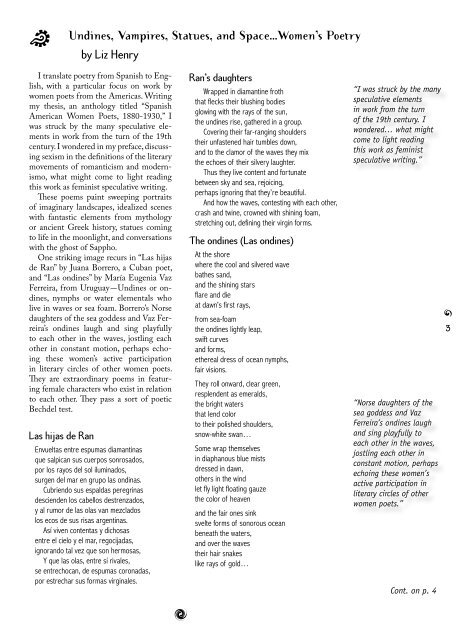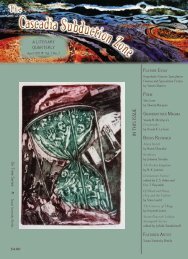Subduction
REviEwEd - The Cascadia Subduction Zone
REviEwEd - The Cascadia Subduction Zone
- No tags were found...
Create successful ePaper yourself
Turn your PDF publications into a flip-book with our unique Google optimized e-Paper software.
y<br />
Undines, Vampires, Statues, and Space...Women’s Poetry<br />
by Liz Henry<br />
I translate poetry from Spanish to English,<br />
with a particular focus on work by<br />
women poets from the Americas. Writing<br />
my thesis, an anthology titled “Spanish<br />
American Women Poets, 1880-1930,” I<br />
was struck by the many speculative elements<br />
in work from the turn of the 19th<br />
century. I wondered in my preface, discussing<br />
sexism in the definitions of the literary<br />
movements of romanticism and modernismo,<br />
what might come to light reading<br />
this work as feminist speculative writing.<br />
These poems paint sweeping portraits<br />
of imaginary landscapes, idealized scenes<br />
with fantastic elements from mythology<br />
or ancient Greek history, statues coming<br />
to life in the moonlight, and conversations<br />
with the ghost of Sappho.<br />
One striking image recurs in “Las hijas<br />
de Ran” by Juana Borrero, a Cuban poet,<br />
and “Las ondines” by María Eugenia Vaz<br />
Ferreira, from Uruguay — Undines or ondines,<br />
nymphs or water elementals who<br />
live in waves or sea foam. Borrero’s Norse<br />
daughters of the sea goddess and Vaz Ferreira’s<br />
ondines laugh and sing playfully<br />
to each other in the waves, jostling each<br />
other in constant motion, perhaps echoing<br />
these women’s active participation<br />
in literary circles of other women poets.<br />
They are extraordinary poems in featuring<br />
female characters who exist in relation<br />
to each other. They pass a sort of poetic<br />
Bechdel test.<br />
Las hijas de Ran<br />
Envueltas entre espumas diamantinas<br />
que salpican sus cuerpos sonrosados,<br />
por los rayos del sol iluminados,<br />
surgen del mar en grupo las ondinas.<br />
Cubriendo sus espaldas peregrinas<br />
descienden los cabellos destrenzados,<br />
y al rumor de las olas van mezclados<br />
los ecos de sus risas argentinas.<br />
Así viven contentas y dichosas<br />
entre el cielo y el mar, regocijadas,<br />
ignorando tal vez que son hermosas,<br />
Y que las olas, entre sí rivales,<br />
se entrechocan, de espumas coronadas,<br />
por estrechar sus formas virginales.<br />
Ran’s daughters<br />
Wrapped in diamantine froth<br />
that flecks their blushing bodies<br />
glowing with the rays of the sun,<br />
the undines rise, gathered in a group.<br />
Covering their far-ranging shoulders<br />
their unfastened hair tumbles down,<br />
and to the clamor of the waves they mix<br />
the echoes of their silvery laughter.<br />
Thus they live content and fortunate<br />
between sky and sea, rejoicing,<br />
perhaps ignoring that they’re beautiful.<br />
And how the waves, contesting with each other,<br />
crash and twine, crowned with shining foam,<br />
stretching out, defining their virgin forms.<br />
The ondines (Las ondines)<br />
At the shore<br />
where the cool and silvered wave<br />
bathes sand,<br />
and the shining stars<br />
flare and die<br />
at dawn’s first rays,<br />
from sea-foam<br />
the ondines lightly leap,<br />
swift curves<br />
and forms,<br />
ethereal dress of ocean nymphs,<br />
fair visions.<br />
They roll onward, clear green,<br />
resplendent as emeralds,<br />
the bright waters<br />
that lend color<br />
to their polished shoulders,<br />
snow-white swan…<br />
Some wrap themselves<br />
in diaphanous blue mists<br />
dressed in dawn,<br />
others in the wind<br />
let fly light floating gauze<br />
the color of heaven<br />
and the fair ones sink<br />
svelte forms of sonorous ocean<br />
beneath the waters,<br />
and over the waves<br />
their hair snakes<br />
like rays of gold…<br />
“I was struck by the many<br />
speculative elements<br />
in work from the turn<br />
of the 19th century. I<br />
wondered… what might<br />
come to light reading<br />
this work as feminist<br />
speculative writing.”<br />
“Norse daughters of the<br />
sea goddess and Vaz<br />
Ferreira’s ondines laugh<br />
and sing playfully to<br />
each other in the waves,<br />
jostling each other in<br />
constant motion, perhaps<br />
echoing these women’s<br />
active participation in<br />
literary circles of other<br />
women poets.”<br />
Cont. on p. 4<br />
i<br />
3<br />
n




